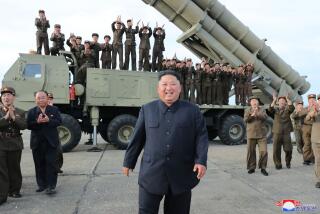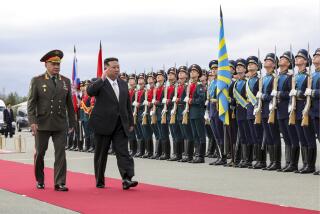U.S.-N. Korea Normalization Is Now in Sight
- Share via
Next week’s visit by a special envoy of North Korean leader Kim Jong Il could reshape the security landscape of northeast Asia. It will do for U.S.-North Korea relations what the Pyongyang summit meeting in June did for North-South relations: put the two sides firmly on the path to peace.
Cho Myong Nok, first vice chairman of the National Defense Commission--the second-highest post in North Korea--will conduct talks with Secretary of State Madeleine Albright on a broad range of issues and meet with President Clinton. Albright, who will host Cho, already has expressed her own willingness to visit Pyongyang before leaving office if the current talks go well. This should lay to rest the widely held view that no deal is possible between Washington and Pyongyang in the final months of the Clinton administration.
Since former Defense Secretary William Perry’s visit to Pyongyang in May 1999 as President Clinton’s special envoy, Washington has hoped for a high-level visitor to come to sign a joint communique in which North Korea declares a formal moratorium on long-range missile testing in exchange for a broad statement on an end to adversarial relations. However, North Korea insisted on its removal from the U.S. list of terrorist states before sending such an envoy.
Once the two sides took steps to deal with the terrorism issue, North Korea offered to send its No. 2 man and chief military representative, suggesting a willingness to work out during the visit a broad political settlement of outstanding issues, not just a narrow quid-pro-quo deal as previously envisioned. Washington quickly agreed to the visit.
This visit could lead to a meeting of leaders of the two nations. With the dramatic improvement in its relations with South Korea, the restoration of its ties underway with its former allies, China and Russia, and its normalization efforts with the European Union, Japan and other countries, now was the time for North Korea to realize its decade-old strategy of bringing its most formidable adversary, the United States, to the peace table.
Since the late 1980s, North Korea has been pushing diplomatically to get the United States to become a friend. It wants U.S. forces to serve as peacekeepers on the Korean peninsula while the two Koreas work out a road map to reunification. Over the longer term, such a redefined U.S. presence would protect Korea from falling under the sway of its powerful neighbors.
From the North Korean perspective, the October 1994 Agreed Framework was not so much a light-water reactor deal as an attempt to lock the United States into political and economic engagement. North Korean requests for aid had the same strategic rationale. A missile deal that could be worked out soon would be another major step toward friendly relations.
As the North eases U.S. concerns about its nuclear weapons and missile capabilities, three-way talks involving the United States and the two Koreas can begin to defuse the armed confrontation on the DMZ. South Korea’s President Kim Dae Jung, who wholeheartedly welcomed the news of Cho’s visit to the United States, has called for the resumption of four-party peace talks in which the two Koreas would reach a peace treaty to be subsequently ratified by the United States and China, the other belligerents in the Korean War.
But the United States must be more involved in easing the military standoff. It can serve as an honest broker between the two Koreas, not on the model of Camp David but as a stabilizer and harmonizer. The U.S. was involved in dividing the Korean peninsula. It must now help bring peace to this troubled land and thereby secure its long-term presence in the region.
More to Read
Sign up for Essential California
The most important California stories and recommendations in your inbox every morning.
You may occasionally receive promotional content from the Los Angeles Times.












